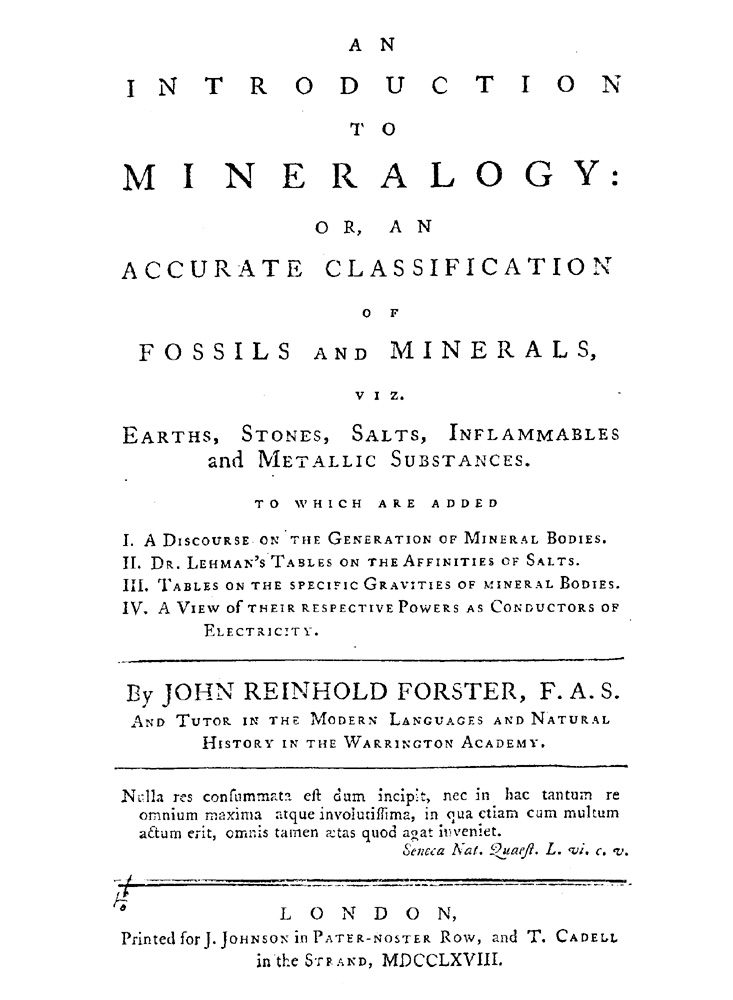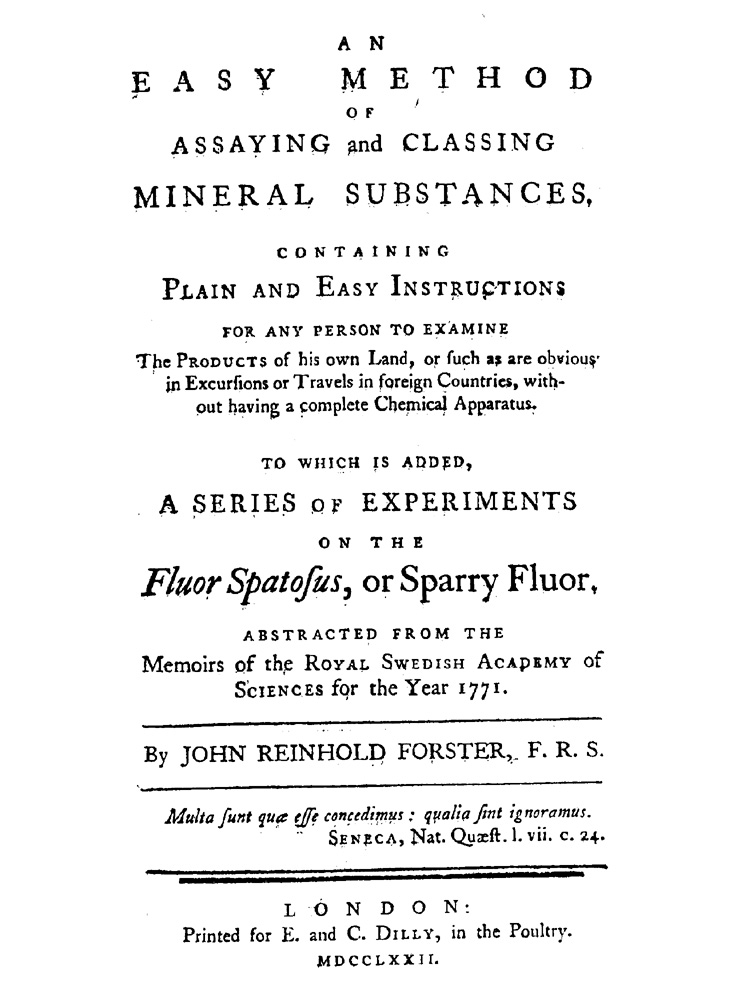FORSTER, Johann Reinhold.
(1729 – 1798)
Father of the renowned naturalist Johann Georg Adam Forster [1754-1794], Johann Reinhold was a man of great scientific attainments, but an intractable temper. Commissioned by empress Catherine to survey the Russian colonies of Saratov province, Forster quarreled with the government and left with his family for England. There he obtained a position as instructor of natural history and modern languages at the nonconformist academy at Warrington. His temper soon compelled him to resign this appointment, and was forced for several years to earn a living publishing translations. An invitation to accompany Captain Cook on his third voyage around the world was accepted on the condition that his son, Johann Georg Adam be his assistant. The account of these travels was published by the son as A Voyage round the World (London, 1777; German, Berlin, 1778-80), which is considered the "first example of the glowing yet faithful description of natural phenomena which has since made a knowledge of them the common property of the educated world." [Encyc. Brit.] After returning to England, Johann Reinhold landed in debtor's prison, but was released after receiving a professorship at the University of Halle, where he remained the rest of his life.
Biographical references: ADB: 7, 166-72. • Australasian Biographical Archive: 123, 288-305. • BBA: I 418, 286-309; II 1480, 326. • Catalogue of Portraits of Naturalists: 440-1 [4 portraits listed]. • DBA: I 334, 101-240; II 385, 168-192. • Drugulin, Sechstausend Portraits, 1863: nos. 1663-8 & 6111. • DSB: 5, 76-7 [by M.E. Hoare]. • Encyclopaedia Britannica, 11th edition. • Hoare, M.E., "Johann Reinhold Forster (1729-1798)", Problems of Natural History, 6, (1971), 1-8. • Hoare, M.E., "Johann Reinhold Forster-The Neglected `Philosopher' of Cook's Second Voyage (1772-1775)", Journal of Pacific History, 2, (1967), 215-24. • Hoare, M.E., "A strange and eventful history: the scientific correspondence of J.R. Forster (1729-98)", Records of the Austrailian Academy of Science, 2, (1972), no. 3, 76-77. • Hoare, M.E., "`Ulysses' or `incubus'? J.R. Forster's first period in England, 1766-1772", Journal of the Society for the Bibliography of Natural History, 7, (1976), no. 4, 375-383. • ISIS, 1913-65: 1, 427. • NDB: 5, 301-2 [by G. Steiner]. • Poggendorff: 1, cols. 775-6. • Sarjeant, Geologists, 1980: 2, 1026-7, Suppl. 1 (1986), 1, 423-4 & Suppl. 2 (1995), 1, 625. • Stafleu & Cowan, Taxonomic Literature, 1976-88: 1, 859-61. • WBI. • World Who's Who in Science: 589-90.

1. English, 1768.
An | Introduction | to | Mineralogy: | or, an | Accurate Classification | of | Fossils and Minerals, | viz. | Earths, Stones, Salts, Inflammables | and Metallic Substances. | To which are added | I. A Discourse on the Generationof Mineral Bodies. | II. Dr. Lehman's Tables on the Affinities of Salts. | III. Tables on the specific Gravities of Mineral Bodies. | IV. A View of their respective Powers as Conductors of Electricity. | [rule] | By Johann Reinhold Forster, F.A.S. | And Tutor in the Modern Languages and Natural | History in the Warrington Academy. | [rule] | [...3 lines of Latin quotation, signed Seneca...] | [rule] | [rule] | London, | Printed for J. Johnson in Pater-Noster Row, and T. Cadell | in the Strand, MDCCLXVIII.
8°: π4 B1 A23 C-M2 N-S4; 52l.; [3], [1], [1]-3, [1], [1]-96 p. Page size: 205 x 122 mm.
Contents: [2 pgs], Title page, verso blank.; [1 pg], Dedication to the President and Vice President of the Warrington Academy, signed John Reinhold Forster.; [1 pg], Blank.; [1]-3, "Advertisement."-dated 1 March 1768.; [1 pg], Blank.; [1]-2, "Introduction."; 3-69, Text.; [70]-85, "Halotechnia: | or, | Tables on the Affinities of Salts: | Translated from the Latin of Dr. John Gottlob Lehmann."; [86]-93, "A Table | of the | Specific Gravities | of | Mineral Bodies, collected from Various Authors."; [94]-96, "A View | of the | Mineral Bodies | considered as | Conductors of Electricity, | taken from | Dr. Joseph Priestley's History of Electricity."
Rare. In the Advertisement, Forster describes his disappointment at not finding a suitable textbook in English to teach mineralogy. He recounts problems with the previous publications of Webster, Hill, Woodward, and Da Costa, and continues, "I found myself under the necessity of drawing up a short sketch of my own, adapted in the best manner I could imagine to the use of my class." Forster than describes how Lehmann presented him with a copy of his "Tables" when Forster visited St. Petersburg several years before. This book, meant to be the first volume of a general natural history (never completed), attempts to classify minerals on a purely chemical basis. It also discusses the generation of mineral bodies, including theories on the general structure of the earth. The relationship between various salts is described in a series of tables translated from Johann Gottlob Lehmann's Kurzer Entwurf einer Mineralogie (2nd ed., Berlin, 1760). Other tables show the specific gravities of various minerals. The volume closes with a consideration of the electric conductivity of minerals based on Joseph Priestley's History of Electricity (1st ed., London, 1762).
Bibliographical references: Berlinische Sammlungen: 3, 642 & 6, 491. • BL [T.282.(4.)]. • Dana's 7th (Bibliography): 70. • Gaz. Litt. de l'Eur.: (Nov., 1768), 170. • Journal encyclopédique.: 4 (1768), 144 & 6 (1769), 145. • LKG: XII 63.

2. English, 1772.
An | Easy Method | of | Assaying and Classing | Mineral Substances, | containing Plain and Easy Instructions | for any person to examine | The Products of his own Land, or such as are obvious | in Excursions or Travels in foreign Countries, with- | out having a complete Chemical Apparatus, | to which is added, | A Series of Experiments | on the | Fluor Spatosus, or Sparry Fluor. | Abstracted from the | Memoirs of the Royal Swedish Academy of | Sciences for the Year 1771. | [rule] | By John Reinhold Forster, F.R.S. | [rule] | Muta sunt quæ esse concedimus; qualia sint ignoramus. | Seneca, Nat. Quæst. 1. vii. c. 24. | [rule] | [rule] | London: | Printed for E. and C. Dilly, in the Poultry. | MDCCLXXII.
8°: π1 B-C8 D6; 23l.; [2], [1]-44 p. Page size: 205 x 122 mm.
Contents: [2 pgs], Title page, verso blank.; [1]-44, Text.
Very scarce. The book begins with an account of the apparatus and precautions necessary for successful chemical analysis of minerals. This is followed by analytical descriptions of minerals classified under the headings of Earthy and Stony, Saline, Inflammable and Metallic. At this point, with its own title page, is the section concerning Sparry Fluor, today known as the mineral Fluorite. Originally authored by the Swedish chemist Carl William Scheele [1742-1786] and published in the Memoirs of the Royal Swedish Academy for 1771, this paper describes a series of interesting chemical investigations performed on samples of Sparry Fluor. These experiments include its combination with alkali and saline media, and the creation of hydrofluoric acid upon its reaction with hydrochloric acid.
Bibliographical references: BL [953.e.6.(2.)]. • Dana's 7th (Bibliography): 70. • Hoover Collection: no. 317. • Kress Catalogue: no. 10859.3. • LKG: XII 64.
3. Latin, 1795.
Onomatologia nova systematis oryctognosiæ, vocabulis latinis expressa a Joanne Reinholdo Forster ... [Halle,] Typis Orphanotrophei Halensis, 1795.
2°: 3 p.
Extremely rare. Concerns the nomenclature of oryctognosy.
Bibliographical references: BL [B.348.(3.)]. • LKG: VII 3.
Tiberius Cavallo ... Mineralogische Tafeln, welche sowohl die Systematische Anordung ... uebersetzt von Johann Reinhold Forster ... (Halle, 1786).See under: Cavallo, Tiberius.Tiberius Cavallo ... Mineralogische Tafeln, welche sowohl die Systematische Anordung ... uebersetzt, verbessert und vermehrt in dieser zweiten Auflage von D. Johann Reinhold Forster ... (Halle, 1790).
See under: Cavallo, Tiberius..
